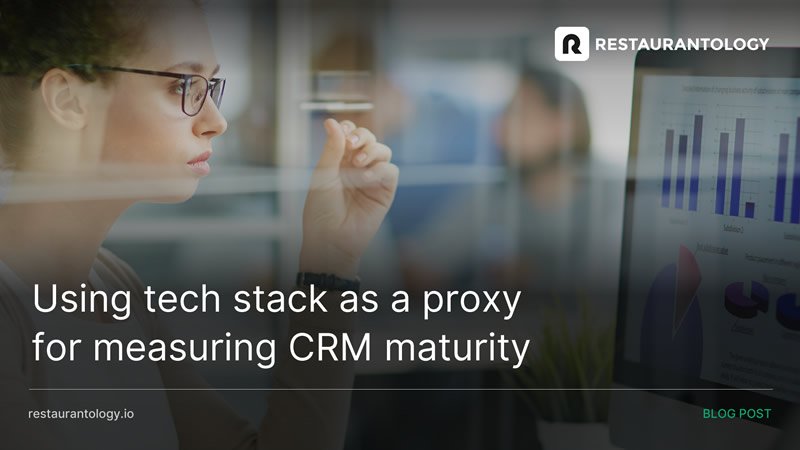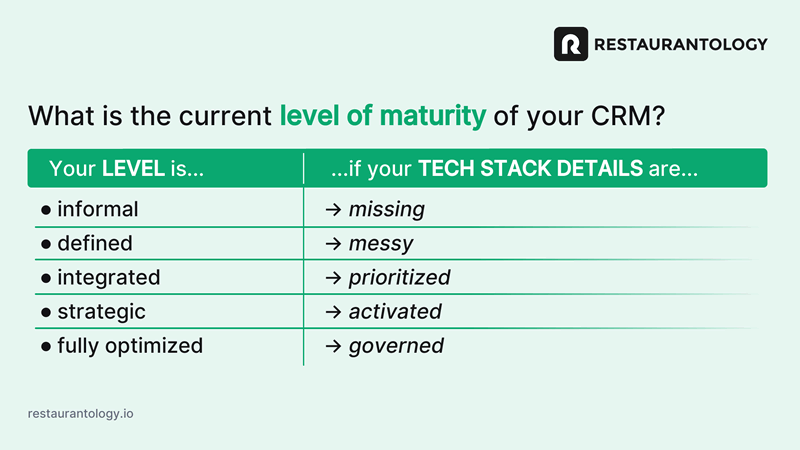Using tech stack as a proxy for measuring CRM maturity

In 2023, the number of companies selling to restaurants that want, or outright need, to know what’s in a restaurant’s tech stack is on the rise.
And modern market intelligence providers are aware of this trend, because delivering verified technographic insights has become non-negotiable. Thankfully, with over 350 industry-specific software that can be uniquely detected when visiting a restaurant’s website (and counting), it’s never been easier to isolate and subsequently incorporate reliable tech attributes into our CRMs. From there, sales and marketers can segment the total addressable market into [01] actionable territory plans, and [02] data-enriched ICPs.
So how are companies ingesting tech stack details into their CRM today?
As it turns out, there’s quite a spectrum. Here’s a breakdown of what I’ve learned after speaking with nearly a hundred B2Bs targeting restaurants.
5 Levels of CRM Maturity
Level One | Informal
At this stage, tech stack details are missing. Structurally, the CRM often lacks the dedicated fields needed to meaningfully group together Accounts by similar attribute. Point of Sale (POS) or other findings are typically buried in open-text fields or, worse yet, stuck inside brains and outside of your CRM.
Primary data acquisition strategies rely on individual efforts rather than processes. Sales reps are responsible for manually entering data, which can result in incomplete and outdated information.
The approach is chaotic, ad hoc, and reactive.
Level Two | Defined
At this stage, tech stack details are messy. Specific fields for tech stack details are introduced into the CRM, such as a picklist for POS type. Technographic reporting across Accounts emerges, but is still subject to human input and validation.
Data acquisition strategies are often twofold: training reps to document qualification or discovery findings in relevant for-purpose fields, and perhaps importing moment-in-time snapshots for any portion(s) of the industry where lists can be obtained.
This approach is the default for most companies.
Level Three | Integrated
At this stage, tech stack details are prioritized. Admins have emphasized that the CRM can no longer house bad technographic data, and have proposed a scalable solution that intentionally seeks out as much verified data as possible. Field validation increases, and process automation is introduced to ensure data entry is minimal, which in turn allows quota-carriers to focus on generating revenue.
Data acquisition strategies turn towards integrated data pipelines from market intelligence partners with reliable datasets. Learn more: The future of CRM data is integrated.
This approach is trending as modern data acquisition accelerates.
Level Four | Strategic
At this stage, tech stack details are activated. With ongoing tech stack updates, businesses begin to implement CRM processes that are aligned with their strategic initiatives. TAM reporting and tech-specific ICP segmentation happen in the CRM, and incorporate industry trends via recent detections.
Automated data acquisition has unlocked industry-wide reporting where competitors and market conditions can be thoroughly vetted. Partners, channels, and integrations can all be evaluated strategically to help de-risk future investments.
This approach is deemed most desirable, while remaining realistic, by RevOps professionals evaluating future-state CRM requirements.
Level Five | Fully Optimized
At this stage, tech stack details are governed. CRM prioritization is adopted organization-wide, and job descriptions, stakeholders, and OKRs are put in place to ensure data acquisition, process automation, and strategic initiatives find internal, ongoing ownership.
Modernized data acquisition has become one element in a much larger data governance framework.
This approach is often only achievable for large enterprises.

The benefits of having a mature CRM
The importance of tracking restaurant tech stacks in your system of record cannot be overstated. Using technographics as a proxy, it becomes both possible and essential to measure your current level of CRM maturity, and to outline the necessary steps to move up the ladder. By doing so, your CRM will become more efficient, effective, and strategic, providing you with a significant competitive advantage in the market.
A mature CRM that tracks restaurant tech stacks effectively will ultimately:
- Improve accuracy and completeness of data → increase your visibility into TAM and ICP.
- Drive operationalized account coverage and prioritization → enhance sales and marketing impact.
- Accelerate your go-to-market strategy → increase revenue and profitability.
With a solid understanding of the five levels of CRM maturity, you can spot check where you are now, and benchmark where you want to be in the near future.

